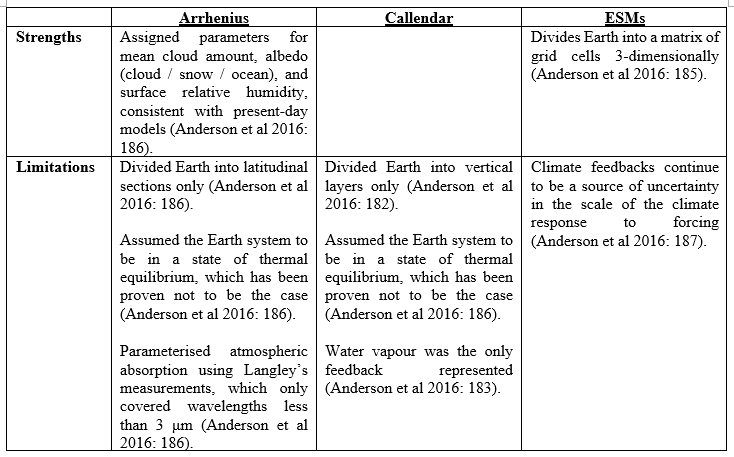Earth System Models
Earth system models (“ESMs”) describe changes in the weather and climate systems, thereby allowing us to reproduce past climates and generate weather forecasts (Met Office). ESMs also build projections of climate warming, assisting in the formulation of climate adaptation and mitigation measures (Anderson et al 2016: 185). This work is achieved by the analysis of the core physics, i.e. the laws of radiative transfer, or, baseline warming (Anderson et al 2016: 186), in combination with additional climate feedbacks (Anderson et al 2016: 178).
Climate feedbacks, or system feedbacks, are factors within the climate system which add some unpredictability, in terms of magnitude, to the projections made by ESMs (Anderson et al 2016: 178). These are broadly physical factors, biogeophysical and biogeochemical factors, as well as factors associated with ice sheets (Arias et al 2021: 20). Some key feedback processes include alterations in global heat redistribution within and between the atmosphere and ocean, reflection of solar radiation by reason of the melting of ice and snow, carbon storage by plants, and changes in clouds and atmospheric water vapour (Anderson et al 2016: 179).
Climate feedbacks, taken in aggregate, intensify global warming (Arias et al 2021: 94), and clouds are the greatest contributor to scale-related uncertainty (Arias et al 2021: 95).
Climate models, of which ESMs are the most recent iteration, can be said to have originated with the explorations of Svante Arrhenius (1859-1927) on the relationship between radiative warming and the greenhouse effect (Anderson et al 2016: 179). In his “pen and paper” calculations, Arrhenius sought to understand the influence of CO₂ on the planetary energy budget, that is, the balance between incoming solar radiation and outgoing re-emitted infrared radiation absorbed by the atmosphere (Anderson et al 2016: 180).
In his investigations into the link between warming and CO₂, by studying monthly average temperature records from 1880 to 1935, Guy Stewart Callendar (1898-1964) arrived at a global land temperature increase of approximately 0.3 degrees Celsius during that period, corresponding to a 6% rise in atmospheric CO₂ concentrations (Anderson et al 2016: 181-182). Callendar also concluded (amongst others) that about half of the warming during that period was a result of increases in CO₂ content in the atmosphere (Anderson et al 2016: 182).
Today, ESMs use three-dimensional depictions of heat, water, and carbon (Anderson et al 2016: 185), as well as all relevant climate feedbacks, to simulate and understand the behaviour of the weather and climate systems. According to current ESM projections, climate warming will entail temperature increases of between 1 to 3.7 degrees Celsius during the 21st century, subject to future emissions of greenhouse gases (Anderson et al 2016: 178).
The table below summarizes some strengths and limitations of the models developed by Arrhenius and Callendar, and of current ESMs.
References:
Anderson, T.R., E. Hawkins, and P.D. Jones. (2016). ‘CO2, the greenhouse effect and global warming: from the pioneering work of Arrhenius and Callendar to today's Earth System Models’. Endeavour, Volume 40, Issue 3, 2016, Pages 178-187, ISSN 0160-9327, https://doi.org/10.1016/j.endeavour.2016.07.002
Arias, P.A., N. Bellouin, E. Coppola, R.G. Jones, G. Krinner, J. Marotzke, V. Naik, M.D. Palmer, G.-K. Plattner, J. Rogelj, M. Rojas, J. Sillmann, T. Storelvmo, P.W. Thorne, B. Trewin, K. Achuta Rao, B. Adhikary, R.P. Allan, K. Armour, G. Bala, R. Barimalala, S. Berger, J.G. Canadell, C. Cassou, A. Cherchi, W. Collins, W.D. Collins, S.L. Connors, S. Corti, F. Cruz, F.J. Dentener, C. Dereczynski, A. Di Luca, A. Diongue Niang, F.J. Doblas-Reyes, A. Dosio, H. Douville, F. Engelbrecht, V. Eyring, E. Fischer, P. Forster, B. Fox-Kemper, J.S. Fuglestvedt, J.C. Fyfe, N.P. Gillett, L. Goldfarb, I. Gorodetskaya, J.M. Gutierrez, R. Hamdi, E. Hawkins, H.T. Hewitt, P. Hope, A.S. Islam, C. Jones, D.S. Kaufman, R.E. Kopp, Y. Kosaka, J. Kossin, S. Krakovska, J.-Y. Lee, J. Li, T. Mauritsen, T.K. Maycock, M. Meinshausen, S.-K. Min, P.M.S. Monteiro, T. Ngo-Duc, F. Otto, I. Pinto, A. Pirani, K. Raghavan, R. Ranasinghe, A.C. Ruane, L. Ruiz, J.-B. Sallée, B.H. Samset, S. Sathyendranath, S.I. Seneviratne, A.A. Sörensson, S. Szopa, I. Takayabu, A.-M. Tréguier, B. van den Hurk, R. Vautard, K. von Schuckmann, S. Zaehle, X. Zhang, and K. Zickfeld. (2021). ‘Technical Summary’. In ‘Climate Change 2021: The Physical Science Basis. Contribution of Working Group I to the Sixth Assessment Report of the Intergovernmental Panel on Climate Change [Masson-Delmotte, V., P. Zhai, A. Pirani, S.L. Connors, C. Péan, S. Berger, N. Caud, Y. Chen, L. Goldfarb, M.I. Gomis, M. Huang, K. Leitzell, E. Lonnoy, J.B.R. Matthews, T.K. Maycock, T. Waterfield, O. Yelekçi, R. Yu, and B. Zhou (eds.)]. Cambridge University Press, Cambridge, United Kingdom and New York, NY, USA, pp. 33−144. doi:10.1017/9781009157896.002
Met Office. 'Climate Modelling'. https://www.metoffice.gov.uk/weather/climate/science/climate-modelling

